Introduction
Purpose of the Study
This study investigates the perceptions of faculty
currently facilitating instruction in the online
environment. Although studies exist focusing on
instructors’ satisfaction with instructing in the
online format (Awalt, 2003; Conrad, 2004; Dolloph,
2004; Luck & McQuiggan, 2006; Wang, MacArthur,
Crosby, 2003; Wilkes, Simon, Brooks, 2006),
additional research focusing on faculty
perspectives represents an important aspect of
gaining a thorough understanding of the online
format from a research standpoint. For example,
current research fails to adequately scrutinize
the difficulty associated with taking a
face-to-face course and moving it to the online
format, the perceived effects of technical and
pedagogical training on the quality of
instruction, the formats in which faculty prefer
to be trained, and whether or not current online
instructors believe training should be required
prior to instructing online. Through this study
the researcher attempts to address these issues by
quantitatively assessing the beliefs of current
online instructors.
The results of this study present valuable
information for institutions looking to formalize
online learning programs. Additionally, this
study allows faculty considering and currently
teaching online to view the beliefs and
perceptions of experienced online instructors.
Lastly, because the majority of institutions lack
a formal training requirement for new online
instructors (Kosak et al., 2005; Ray, 2009), this
study assists institutions in determining the
value in dictating training courses for
instructors new to the online format and aids
current faculty in the decision of whether or not
to seek training prior to instructing their first
online course.
The Problem
Evidence of considerable growth exists in the
number of students selecting courses in the online
format in the United States. For example, between
2005 and 2006, the number of students
participating in online courses increased by 10
percent, resulting in approximately 20 percent of
students claiming enrollment in at least one class
delivered totally online in the fall of 2006
(Allen & Seaman, 2007). With the rapid increase
in the number of students participating in online
courses combined with the relative newness of this
type of instruction, a number of concerns have
arisen as to the effectiveness of this type of
instruction. Probably stemming from the negative
connotations about online learning, a considerable
amount of research focuses on the quality of
online instruction as compared to traditional
methods of instruction (Shelley, Swartz, & Cole,
2007; Rivera and Rice, 2002; Hauck, 2006).
However, a number of other pervasive concerns
exist within the online learning domain which
deserve copious research as well. For example,
researchers document that online instruction
requires different instructional and technical
tools (Diaz & Botenbal, 2000; Barker, 2003) and
therefore training should be required prior to
instructing online (Trippe, 2002). However, the
majority of instructors new to online learning
receive little to no training (Keramidas et al.,
2007; Kosak et al., 2005; Ray, 2009), and
consequently use the same pedagogical tools
utilized in the traditional, face-to-face
classroom (Conrad, 2004; Dolloph, 2007; Zemsky &
Massey, 2004).
Without faculty demand or empirical evidence about
the effects of training on the appropriate online
instruction, little will be done at the
institutional level to change the current lack of
professional development for online instructors.
As a means of gaining additional insight into the
perception of online faculty, the study was
formulated. Through the subsequent review of
literature and survey of online faculty the
researcher attempts to answer the following
research questions and hypotheses.
Research Questions
RQ1: How difficult is it for faculty to convert a
course from face-to-face to totally online?
RQ2: Would faculty like additional training
opportunities (technical and/or pedagogical)
pertaining to online instruction and in what
format(s)?
RQ3: Who is providing formal training to faculty
currently instructing online?
RQ4: Do current online instructors believe that
technical and/or pedagogical training should be
required prior to instructing online?
Hypotheses
Ho1: Training does not significantly
affect an instructor’s perceived technical
preparation for instructing in the online format
at an α=.05 level.
Ha1: Training significantly affects an
instructor’s perceived technical preparation for
instructing in the online format at an α=.05
level.
Ho2: Training does not significantly
affect an instructor’s perceived
pedagogical/instructional design preparation for
instructing in the online format at an α=.05
level.
Ha2: Training significantly affects an
instructor’s perceived pedagogical/instructional
design preparation for instructing in the online
format at an α=.05 level.
Literature Survey
The online learning format is growing rapidly.
Unfortunately, for various reasons, institutions
continue to promote the implementation of online
teaching “without necessarily having staff
competent in all aspects of online pedagogy”
(Sims, Dobbs, & Hand, 2002, p. 136). With the
rapid rise of online courses, questions have been
raised as to the capacity of faculty to
successfully instruct in the online format.
Unlike teaching face-to-face where instructors may
lack technical knowledge and still effectively
teach students, in the arena of distance
education, educators must possess a thorough
understanding of technology as well as the subject
matter expertise required in the traditional
classroom (Darabi, Sikorski, & Harvey, 2006).
Aside from the obvious technical challenges
associated with developing a course in the online
medium, researchers indicate a need for additional
faculty training specifically focusing on the
different methods of instruction and pedagogy
necessary to facilitate and instruct a successful
online course (Diaz & Bontenbal, 2000; Arabasz,
Pirani, & Fawcett, 2003; Okojie, Olinzock, &
Okojie-Boulder, 2006).
In contrast, research also indicates that
instructors hold the perception that online
instruction is similar in design and pedagogy, if
not the same as traditional teaching (Diaz &
Cartnell, 1999; Alexander & Boud, 2001; Arabasz,
Pirani, & Fawcett, 2003). First time online
instructors often believe that moving their
lectures and their exams to the online format
constitutes teaching online (Sieber, 2005).
However, Sieber (2005) found that after teaching
online, instructors state that besides “mastering
the technology,” they must also “master the art of
guiding and motivating students” through the
course (p. 338). This disconnect fuels the
dichotomy of faculty training; that is, first-time
instructors feel prepared from a pedagogical
perspective to instruct online, even though
research suggests that instructors require
additional training to successfully conceptualize,
design, and deliver an online course.
Transitioning to the Online Environment
Studies indicate that the majority of instructors
utilize the same pedagogical tools in the online
medium that they learned for face-to-face
instruction (Zemsky & Massey, 2004; Conrad, 2004;
Dolloph, 2007). Although faculty tend to use the
same pedagogical tools in the traditional and
online classroom, trying to replicate all of the
interaction, activities, and events that take
place during a face-to-face classroom within the
context of the online medium remains virtually
impossible (Sugar, Martindale, & Crawley, 2007).
Those new to online instruction cite past
experiences in the classroom as providing the
means for which they handle online pedagogical
issues (Conrad, 2004). However, emulating
face-to-face instruction in the online classroom
is unfeasible and impractical (Sugar, Martindale,
&
Crawley, 2007). As a result, expecting “experienced
face-to-face faculty to magically begin to
function well in the online environment” is
unreasonable due to the lack of pedagogical
transferability from the traditional to the online
classroom (Smith, 2005, p. 11).
This magical understanding of proper instruction
in the online format does not occur naturally.
According to Gold (2001), an instructional
technologist, “without proper pedagogical training
and online experience, teachers will continue to
replicate their best existing practices onto the
online medium” (p. 36). If institutions expect
faculty to successfully transition to the
web-based classroom, instructors must be educated
on best practices in online learning (Li, Lee,
Bonk, Su, & Magjuka, 2005).
Additionally, a Bates and Watson (2008) study
further emphasized the need for pedagogical
training by identifying specific skills that must
be attained by instructors to ensure quality
online instruction, including, appropriate design
of courses, effective use of activities, and a
thorough understanding of technology. Bates and
Watson pronounced that to successfully instruct
online, one cannot “make a physical move from
standing in front of a class to typing on a
keyboard, and keep everything else the same” (p.
40). In the conclusion of their study of two
online instructors, the instructors acknowledged
that virtual teaching, whether partially or
totally online required a different set of
teaching skills and methods.
Finally, a study focused on faculty perceptions of
online learning surveyed the population of
Penn State University’s World Campus (Luck &
McQuiggan, 2006). In this study, the participants
provided suggestions to instructors moving into
the web-based classroom for the first time. All
of the suggestions related to instructor
preparation, including viewing a course already in
the online format, taking part in online learning
as a student, discussing online instruction with
someone familiar with taking courses online,
becoming comfortable with the technology, and
seeking assistance from a technical and design
perspective.
Failure to Train Online Instructors
Although researchers document the importance of
training instructors prior to teaching online for
the first time, the majority of institutions fail
to do so (Keramidas et al., 2007). These
institutions, partaking in the “individual model
of distance education,” force faculty to “fend for
themselves in the virtual world,” oftentimes
leaving instructors new to online learning feeling
“overwhelmed” (Restauri, 2004, p. 33).
Surprisingly, the majority of institutions seem to
subscribe to this hands-off model. In fact, a
study conducted in the
University
of
North Carolina
system (Kosak et al., 2005) found that only half
of respondents acknowledged the availability of
any type of training pertaining to online
instruction at their institution. In the findings
of that same study, although half of the
institutions provided training opportunities for
faculty, a total of only 27% of institutions
actually required faculty to train prior to
teaching an online course. Related to the lack of
training, one faculty member in Lewis’ (2007)
study described her first experience with online
instruction as being “thrust into online courses
without any preparation” (p. 56). She further
indicated the importance of not only offering
training to faculty, but making sure that faculty
receive adequate information about those
opportunities (Lewis, 2007).
Other faculty members confirm the findings of the
Lewis (2007) study. For example, in his
self-reflection of the importance of training for
online instructors, Trippe (2002) fosters the idea
that training should not only be available to
online instructors, but should be required prior
to teaching online for the first time.
Need For Additional Research
Overall, online learning is still a relatively new
concept (Keramidas et al., 2007). Many
opportunities exist for additional research in
almost all aspects of online education. For
example, a lack of research exists that adequately
addresses the training needs of online
instructors, especially those new to the online
format. Hewett and Powers (2007) state that “a
gap exists regarding the specific issue of
training and professional development” and call
for additional “theoretical and empirical
research” of “what works in various online
settings” (p. 3). Similarly, Bates and Watson
(2008) cite a lack of focus in research on how
professors learn to instruct in the online
format. By gaining perspective on faculty
concerns through research, institutions gain
opportunities to better understand the type of
support that faculty needs (McQuiggan, 2006).
Additionally, of the available published articles
focusing on online learning, many lack empirical
evidence to justify the claims made by the authors
and instead focus on the views of the writers (Clark,
2007). Specifically, a focus on faculty
perspectives of online learning (Kinuthia, 2004;
Luck & McQuiggan, 2006), particularly in the areas
of professional development and preparation for
instruction, needs to gain the attention of
researchers. The majority of studies thus far
focus on a single case study, recommendations
based on experiences, and descriptions of
practices, thereby lacking themes that can
transcend all areas of educational technology (Mishra
& Koehler, 2006).
Overall, to provide quality teaching, instructors
must know how to foster student learning in the
virtual classroom. Unfortunately at this point,
the exact prescription for quality instruction in
the online environment is still unknown. However,
if online learning continues to grow at the
expected rates, colleges and universities must
employ faculty competent in online instruction.
As the array of online courses continues to rise
and as greater numbers of students select this
learning format, it is important, if not
imperative, that all aspects of online education
receive additional empirical investigation to
build a valuable knowledge base for continued
improvement in instruction and design of online
courses.
Methods
Through the study described below, the researcher
addressed the perceptions of instructors currently
teaching in the online environment in the
tri-state area of Pennsylvania, Ohio, and West
Virginia. Based on an extensive review of
literature and another study previously conducted
by this researcher (Ray, 2009), this study
materialized.
Design of the Study
The review of literature failed to provide a
survey instrument that satisfied the needs of this
study. A survey was developed that focused
specifically on the perceptions of online
faculty. The researcher first obtained
Institutional Review Board (IRB) approval for
study. Then, the survey was conducted using an
online survey tool called Vovici. Although
web-based surveys are sometimes criticized for
failing to reach all potential participants due to
access issues, the target population of this
particular study consisted of only online
instructors currently teaching in the fall of
2008, so access to the Internet did not represent
a concern or limitation of this study. Prior to
e-mailing the survey, a panel of experts reviewed
the survey for completeness and understanding.
Based on the recommendations of the expert panel,
minor modifications were made to the survey.
Population and Sample
The population of the study was a random selection
of online faculty in the tri-state area of
Pennsylvania, Ohio, and West Virginia that were
teaching at least one totally online course during
the fall of 2008. A total of 21 colleges,
universities, and community colleges were
identified in the state of
Pennsylvania,
5 in Ohio, and 5 in West Virginia for
participation in this study. When possible, ten
faculty members from each of the institutions were
randomly selected from course catalogs and
institutional websites. In the case of
institutions that offered less than ten online
classes or possessed less than ten online faculty
members, all of the identified faculty members
received the survey. For one institution, the
course catalog was not available, so the school
was contacted for a list of online faculty in
various departments in the institution. All ten
of the identified faculty members from that
institution received the survey. In total, the
survey was distributed to 300 faculty members
teaching an online course in the fall of 2008.
Procedure
After the random selection of faculty, all
potential participants received an e-mail
explaining the study and asking for
participation. Potential participants were asked
to respond within two weeks. The survey
participants were intentionally kept anonymous as
to name or institutional affiliation. After one
week, a reminder e-mail was sent. The day before
the close of the survey, one final e-mail was sent
reminding potential participants that the survey
was set to close on the following day.
Survey questions one through five gathered basic
demographic information about the sample. This
information included: years teaching in higher
education, faculty rank, total number of courses
taught totally online, gender, and the type of
institution (college or university and public or
private).
Additionally, the researcher conducted t-tests
where appropriate to examine for significance.
For example, a dependent sample t-test was used to
determine if a statistically significant
difference existed in the perceived technical
preparation of instructors before and after
training. The training session provided to the
faculty member represented the independent
variable, whereas the perceived technical
preparation of the instructor before and after
training represented the dependent variable. The
null hypothesis was Ho1:
mbeforetechnicaltraining=maftertechnicaltraining.
The alternative hypothesis was Ha1:
mbeforetechnicaltraining
¹maftertechnicaltraining.
For this statistical procedure, alpha was set at
.05 and a two-tailed t-test was conducted.
Next, the researcher wanted to determine if a
significant difference existed in the perceived
pedagogical preparation of instructors after
receiving training. The same statistical
procedure outlined above was used with pedagogy
instead of technical preparation. The null
hypothesis was Ho2:
mbeforepedagogicaltraining=mafterpedagogicaltraining.
The alternative hypothesis was Ho2:
mbeforepedagogicaltraining
¹mafterpedagogicaltraining.
Again, alpha was set at .05, a two-tailed t-test
was conducted, and the null hypothesis was
rejected if the p value was found to be less than
.05.
Additionally, the following types of questions
were addressed through the survey. A Likert Scale
question was utilized to address the perceived
difficulty of converting a course from
face-to-face to totally online. Participating
faculty were also questioned as to the type of
training received prior to instructing online (not
trained, Course Management System (CMS)
provided, institution provided, both
CMS and institution provided, or Other).
In addition, yes/no questions were provided to
determine if faculty believed that technical
and/or pedagogical training should be required
prior to instructing online and if participants
wanted additional training opportunities for
themselves related to technology and/or pedagogy.
Lastly, faculty were asked to check the preferred
format(s) of the additional training (one-on-one,
face-to-face small group, face-to-face large
group, web-based, Other).
Results
Out of the 300 surveys e-mailed to potential
participants, 111 were returned, constituting a
37% response rate. Demographic information was
collected, including years teaching in higher
education (Table 1), faculty rank (Table 2), type
of institution (Table 3), number of courses taught
online (Table 4), and gender (Table 5). One
person elected not to provide his or her gender.
All of the other demographic questions were
answered by all participants.
Table 1. Years of Teaching Experience in Higher Education
Years |
Frequency |
Percentage |
0-2 |
1 |
1% |
3-5 |
19 |
17% |
6-8 |
16 |
14% |
9-11 |
15 |
14% |
12 or more |
60 |
54% |
Table 2. Rank of Faculty Participants
|
Rank |
Frequency |
Percentage |
|
Adjunct/
Part-Time |
17 |
15% |
|
Instructor |
14 |
13% |
|
Assistant |
24 |
22% |
|
Associate |
26 |
23% |
|
Full |
30 |
27% |
Table 3. Type of Institution
|
Type |
Percentage |
|
Public University |
62.2% |
|
Private University |
20.7% |
|
Community/Two-Year Colleges |
7.2% |
|
Public College |
5.4% |
|
Private College |
4.5% |
Table 4. Number of Courses Taught Fully Online
|
Courses |
Frequency |
Percentage |
|
Less Than 5 |
51 |
46% |
|
6-10 |
25 |
23% |
|
11-20 |
13 |
12% |
|
21 or More |
22 |
20% |
Table 5. Gender of Participants
|
Gender |
Frequency |
Percentage |
|
Female |
65 |
59% |
|
Male |
45 |
41% |
RQ1: This question addressed the difficulty
associated with moving a course into the online
format (see Figure 1). Of the participants in
this study, over 50% of the respondents classified
converting a course from face-to-face to totally
online as either “hard” or “very hard.”
Subsequently, only 7.2% of respondents classified
this task as “easy” or “very easy.” This
indicates that the majority of instructors
perceive a challenge in moving their courses into
the online format. Additionally, only three of
the participants had never moved a course from
face-to-face to totally online, so this is a
challenge that the majority of instructors are
experiencing.
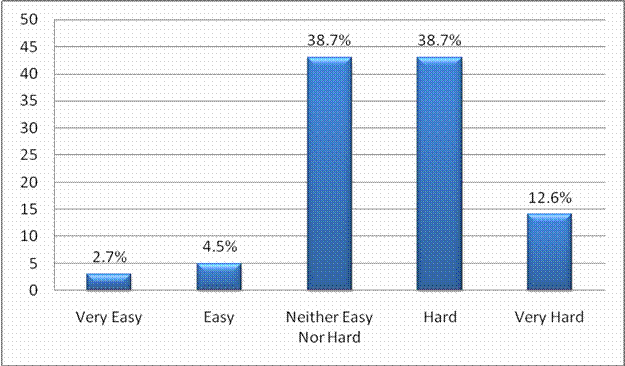
Figure 1. Difficulty of Converting a Course
from Face-to-Face to Online
RQ2:
This question addressed whether or not faculty
desired additional training in pedagogy and/or
technology, and if so, in what format(s). In the
area of technical training 65.8% of respondents
wanted additional training opportunities.
Similarly, 64.6% desired additional pedagogical
training. When looking at the preferred formats
for technical training, small group face-to-face
(37.8%) and web-based (32.4%) received the
majority of responses. Only 4.5% desired large
group face-to-face and 16.2% desired one-on-one
training formats. The preferred format for
pedagogical training was once again led by small
group face-to-face (45%) and web-based (29.7%).
Again, large group face-to-face was selected the
least often (8.1%) followed by one-on-one (16.2%).
RQ3:
This question addressed where instructors get
formal training on how to instruct online. It is
important to note that a large percentage of
instructors were not formally trained in
technology (23.6%) or pedagogy (37.8%) prior to
teaching online. Of those that were formally
trained in technology, 70.9% received institution
provided training and 14.5% received CMS provided
training prior to instructing online (Table 6).
Of those that received formal pedagogical
training, 55.8% received it from the institution
and 9.9% received it from the CMS (Table 7).
Table 6. Formal Technical Training Prior to
Instructing Online for the First time
|
Format of Training |
Frequency |
Percentage |
|
Institution Provided |
65 |
59.1% |
|
CMS Provided |
3 |
2.7% |
|
Institution & CMS Provided |
13 |
11.8% |
|
Other |
3 |
2.7% |
Table 7. Formal Pedagogical Training Prior to
Instructing Online for the First time
|
Format of Training |
Frequency |
Percentage |
|
Institution Provided |
54 |
48.6% |
|
CMS Provided |
3 |
2.7% |
|
Institution & CMS Provided |
8 |
7.2% |
|
Other |
4 |
3.6% |
RQ4:
This question focuses on whether or not
instructors currently teaching online believe that
training should be required prior to instructing
online. The majority of instructors in this study
believed that training should be required prior to
instructing online in both technology and
pedagogy. In fact, 86.5% of the respondents
indicated that faculty new to online instruction
should be required to participate in technical
training prior to instructing online and 84.5%
answered that faculty new to online instruction
should be required to participate in pedagogical
training prior to instructing online.
Ho1:
For this hypothesis the researcher attempted to
address the perceived preparation of online
instructors from a technical perspective prior to
formal training (Figure 2) and after formal
training (Figure 3). In Figure 3, the 28 people
that were not formally trained were not included.
To analyze these results, a paired samples t-test
was conducted to determine if a significant
difference existed between the perceived technical
preparation to instruct online before and after
formal technical training. A statistically
significant difference existed in the perceived
technical preparation of instructors prior to
formal technical training (M=2.02, SD=1.253) and
after formal technical training (M=3.27, SD=.697,
t(84)=-11.245, p<.0005). Therefore, the null
hypothesis was rejected. Additionally, eta
squared, which measures effect size, was
calculated by the researcher and the work of Cohen
(1988) was utilized to analyze the effect size.
Cohen believes that .01 equates to a small effect,
.06 equates to a moderate effect, and .14 equates
to a large effect. Based on Cohen’s (1988) work,
the eta squared statistic (.60) indicated a large
effect.
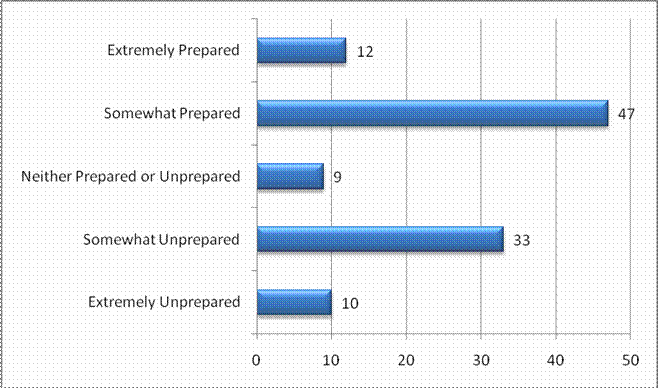
Figure 2.
Perceived Technical Preparation Prior to Formal
Training
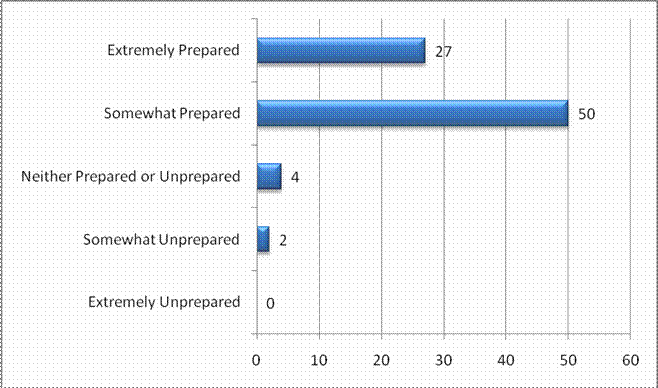
Figure 3. Perceived Technical Preparation After
Formal Train
Ho2:
For this hypothesis the researcher addressed the
perceived preparation of online instructors from a
pedagogical perspective prior to formal training
(Figure 4) and after formal training (Figure 5).
Again, using a paired samples t-test, a
statistically significant difference existed in
the perceived pedagogical preparation of
instructors prior to formal pedagogical training
(M=2.07, SD=1.201) and after formal pedagogical
training (M=3.21, SD=.764, t(67)=-9.282,
p<.0005). Therefore, the null hypothesis was
rejected. To determine the extent of the effect,
eta squared was calculated and again the work of
Cohen (1988) was utilized to indicate the
magnitude of the effect. Again, the eta squared
statistic (.563) indicated a large effect.
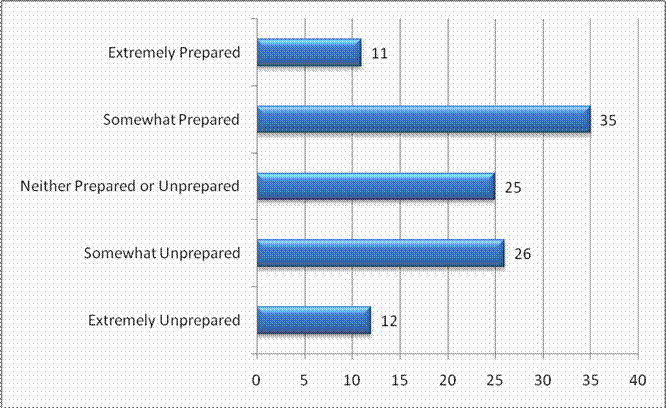
Figure 4. Perceived Pedagogical/Instructional
Design Preparation Prior to Formal Training
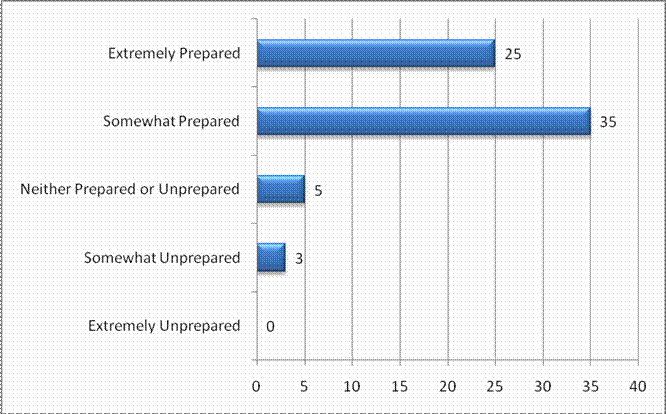
Figure 5. Perceived
Pedagogical/Instructional Design Preparation after
Formal Training
Discussion
This study constituted a few major findings.
First, it found that moving a course from
face-to-face to totally online represents a
difficult task for online instructors. Like
Sugar, Martindale, & Crawley (2007) this study
seems to indicate that the face-to-face classroom
is difficult to replicate in the online
environment. All but three of the instructors in
this study had made the attempt to move at least
one course into the online format. A better
understanding needs to be developed on how to
assist faculty with this transition of moving
content from face-to-face to online.
Additionally, it was found that the majority of
those teaching in the online environment desire
additional opportunities to train in both
technology and pedagogy. They prefer to have
these courses in the web-based or in the small
group face-to-face formats. Like Pankowski
(2003), this study found that instructors believe
in the importance of training and also desire
additional opportunities after they have begun
instructing in the online format. Researchers
have already touted the importance of not only
training prior to instructing online, but also the
need for ongoing training (Barker, 2003; Feist,
2003; Smith, 2005). This study shows that not
only researchers possess this belief, but also
that instructors agree with the need for ongoing
professional development.
A third finding in this study is that a large
percentage of instructors are not being trained to
teach online in either pedagogy or technology
(37.8% and 23.6% respectively). This finding is
congruent with other studies and shows that
institutions still lack policies requiring
instructors to train prior to teaching online and
some still fail to provide any training
opportunities to their professors (Keramidas et
al., 2007; Kosak et al., 2005; Ray, 2009). This
finding is quite alarming given the next finding
of this study which indicates that those currently
teaching online ultimately believe that technical
and pedagogical training should be required prior
to allowing someone to instruct online.
In fact, an overwhelming 86.5% of the respondents
thought that faculty new to online instruction
should be required to participate in technical
training prior to instructing online and 84.5%
believed that faculty new to online instruction
should be required to participate in pedagogical
training prior to instructing online. Although
few in number, some studies have concluded that
online instructors believe that training should be
required prior to instructing online. For
example, in a Bates and Watson (2008) study,
participants concluded that teaching online
required very different skills.
Lastly, and arguably the most important finding in
this study is that training faculty in technology
and pedagogy prior to instructing online resulted
in a significant difference in the perceived
preparation of instructors to teach in the online
format. Similarly, in a study of pharmacy
instructors (LeBlanc, Pruchnicki, Rohdieck, Khurma,
& Dasta, 2007) just three hours of training
resulted in a significant increase in instructors’
perceived ability to instruct online. Although the
specific methods of training received are unknown
in this study, it can be assumed that the training
varied widely among these participants.
Regardless of the format, the training received
prior to instructing online in both technology and
pedagogy had a positive effect on the instructor’s
perceived preparation to teach online.
Conclusions
With the relative newness of the online format,
there is much to be learned and addressed from a
research standpoint. This study adds to one
important body of knowledge about online learning,
the faculty perspective. Although this study only
represented instructors in Pennsylvania, Ohio, and
West Virginia, it could be argued that the
population of this study was representative to the
general population of instructors currently
teaching in the online format due to the fact that
the instructors were randomly selected from many
different institutions and various departments,
had various levels of experience in higher
education, and also possessed a range of
experience in the online format.
This study showed that those teaching in the
online format believe in the importance of
training instructors prior to teaching online.
Because of this finding, it becomes important for
institutions of higher learning to address this
concern. Instructors teaching in the online
format realize the differences associated with
instructing online versus teaching in the
face-to-face classroom and are struggling to move
their course content into the online format.
Additionally, instructors not only desire training
prior to teaching for the first time in the online
format, but they also desire ongoing training
opportunities after they have begun to teach
online. The recommendation of this researcher is
for all institutions to review their current
training offerings for online instructors. If no
program exists to train instructors prior to
instructing online in both technology and
pedagogy, one should be formed. Additionally,
institutions should find a way of addressing the
training needs of those already instructing in the
online format. Lastly, additional research needs
to be conducted to find the appropriate
prescription for adequately preparing instructors
to teach online.





